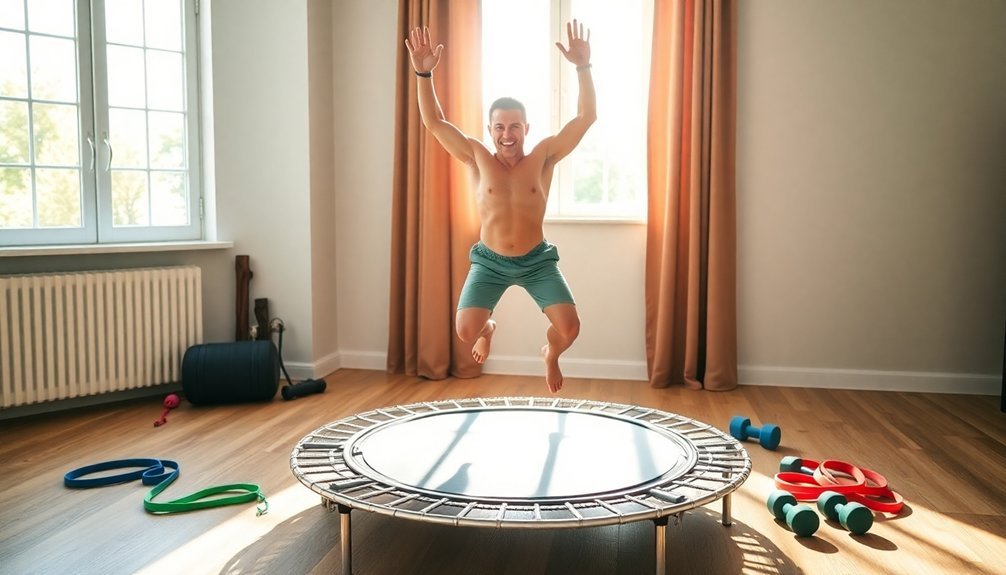Master mini-trampoline workouts by starting with proper bouncing techniques—feet wider than hips, knees slightly bent, and core engaged. Create 20-minute HIIT routines with 30-second intensity bursts followed by 15-second recoveries. Incorporate upper body movements using light weights for full-body engagement. Use music to time your intervals and maintain motivation. Combine trampoline sessions with resistance training for thorough fitness results. These five strategies will transform your home cardio routine into an efficient calorie-burning powerhouse.
Start Light: Master Basic Bouncing Techniques for Joint Safety

When you first step onto a mini-trampoline, proper technique matters more than intensity. Position your feet wider than hip-width apart with slightly bent knees to establish stability. Keep your weight evenly distributed and engage your core to protect your lower back.
Focus on controlled, low-impact bouncing rather than high jumps. The "bounce down" technique—pressing your heels into the trampoline surface—builds proper form while maintaining joint safety. Remember to breathe deeply and steadily throughout your session.
Begin with basic bounces before adding arm movements to enhance coordination and cardiovascular benefits. Maintaining full foot contact with the mat ensures proper weight distribution and reduces injury risk. Many beginners make the mistake of skipping warm-ups or rushing to increase intensity.
Instead, listen to your body, maintain good posture, and progress gradually. This approach will improve your coordination, confidence, and consistency while protecting your joints.
Create a 20-Minute HIIT Routine to Maximize Calorie Burn
High-intensity interval training on a mini-trampoline delivers maximum calorie burn in minimal time when structured properly.
Mini-trampoline HIIT maximizes calorie burn efficiency through strategic intensity cycles and minimal time investment.
Design your routine with 30-second intense work periods followed by 15-second recovery breaks to keep your heart rate elevated while preventing excessive fatigue. You'll burn 150-400 calories while triggering afterburn effects that continue for hours post-workout.
- Warm up for 3 minutes with gentle bouncing and arm circles before launching into intervals combining moves like jump squats, high knees, and lateral bounds. For optimal preparation, incorporate dynamic movements like knee pops and scissors as demonstrated in Michelle's warm-up sequence.
- Complete 8-10 rounds of your selected exercises, maintaining maximum effort during work periods to engage anaerobic metabolism.
- Schedule sessions 2-3 times weekly to balance results with recovery, preventing cortisol spikes and supporting muscle repair.
Incorporate Upper Body Movements to Target Multiple Muscle Groups

While HIIT routines dramatically boost your cardio capacity, adding upper body movements to your mini-trampoline workout transforms it into a thorough full-body session.
By combining cardio and strength training, you'll maximize efficiency and increase calorie burn while engaging multiple muscle groups simultaneously.
Try incorporating shoulder rolls and arm circles as warm-ups, then progress to weighted bicep curls with light dumbbells while bouncing. Using 1.5 kg dumbbells for bouncing exercises provides just enough resistance without compromising stability or form.
For more intensity, attempt modified push-ups or tricep dips using the trampoline's edge. Always maintain a soft bend in your knees for stability.
Remember to alternate between different arm movements during your cardio segments and incorporate rhythmic patterns to maintain consistent tempo.
This approach not only improves coordination and balance but also guarantees you're getting a detailed workout that targets both upper and lower body.
Use Music-Based Intervals to Maintain Consistent Workout Intensity
Have you ever noticed how a perfect song can transform your workout from mundane to exhilarating? On your mini-trampoline, music isn't just entertainment—it's a powerful tool for maintaining consistent intensity.
Faster tempos naturally increase your heart rate and energy output, while slower beats work perfectly for warm-ups and cool-downs. The trampoline provides low impact exercise that's gentle on your joints while still delivering high-intensity cardiovascular benefits.
Create structured intervals that sync with your playlist to maximize your cardio benefits:
- Design a varied playlist with high-energy tracks for intense bouncing followed by moderate tempos for recovery periods.
- Time your intervals with music changes – try 60 seconds of high-intensity work during chorus sections followed by 30 seconds of recovery.
- Match movements to beats – coordinate your bounces, twists and arm movements with the rhythm for better form and engagement.
Combine Trampoline Sessions With Resistance Training for Full-Body Results

To achieve truly transformative fitness results, your mini-trampoline shouldn't stand alone in your workout routine.
Integrating resistance training with your bounce sessions creates a thorough workout that targets multiple muscle groups while maintaining the low-impact benefits you love.
Combine bounce and resistance for maximum results while protecting your joints and amplifying your fitness journey.
Try adding resistance bands or free weights during your trampoline workout.
You'll increase caloric burn both during and after exercise while strengthening muscles that cardio alone doesn't fully engage.
This combination is particularly effective for breaking through fitness plateaus.
Create a simple circuit by alternating between 2-minute trampoline intervals and strength exercises like band rows, squats with weights, or pushups.
This approach delivers cardiovascular benefits while building muscle—all from the convenience of your home with minimal equipment and space requirements.
Trampoline workouts provide a low-impact, high-intensity exercise that's safer on your joints than traditional cardio while still delivering exceptional results.
Frequently Asked Questions
How Long Does a Mini Trampoline Typically Last With Regular Use?
With regular use, your mini trampoline will last 1-3 years for moderately priced models, while high-quality ones can endure 3-5 years. You'll get longer life if you maintain it properly.
Can Children Safely Use Adult Mini Trampolines for Exercise?
No, children under 6 shouldn't use adult mini trampolines due to injury risks. For older kids, guarantee supervision, teach proper techniques, and limit use to one child at a time for safety.
What's the Weight Limit for Most Standard Mini Trampolines?
Most standard mini trampolines support between 100-220 pounds, though some fitness-focused rebounders can handle up to 300 pounds. You'll want to check your specific model's guidelines to verify safe usage.
Is Rebounding Safe During Pregnancy or Postpartum Recovery?
Avoid rebounding during pregnancy due to balance issues and pelvic strain. After childbirth, you'll benefit from it once you've healed properly – it's excellent for rebuilding your pelvic floor and core strength during postpartum recovery.
How Does Rebounding Compare to Swimming for Cardiovascular Benefits?
While both offer strong cardiovascular benefits, swimming provides more consistent heart health improvements. You'll get comparable VO2 max gains from rebounding, but you can easily adjust intensity levels based on your fitness goals.
In Summary
You've now got everything you need to turn your mini-trampoline into a serious cardio powerhouse. Start with basic bounces, build up to HIIT sessions, engage your upper body, use music for motivation, and mix in resistance training. You'll boost your fitness while protecting your joints and keeping workouts fresh. Give these techniques a try—your heart, muscles, and mind will thank you!





Leave a Reply